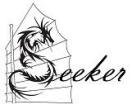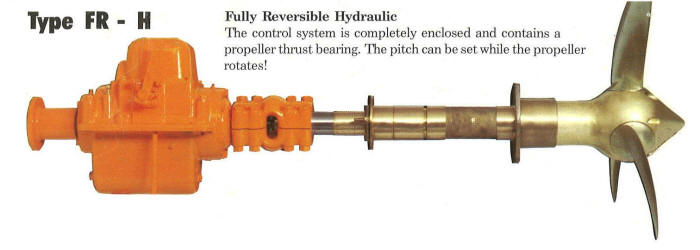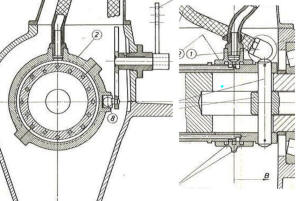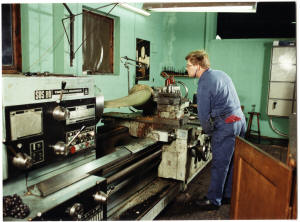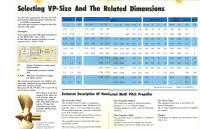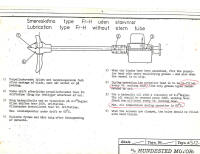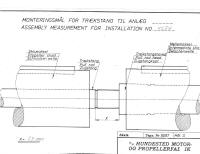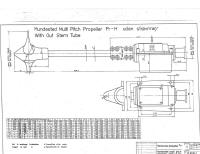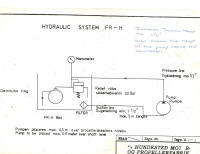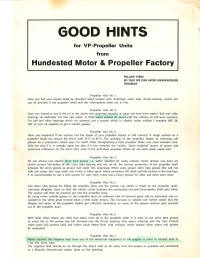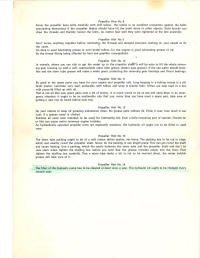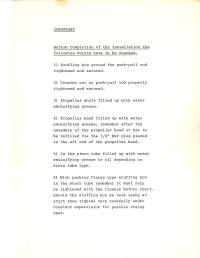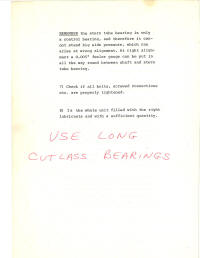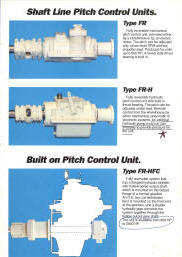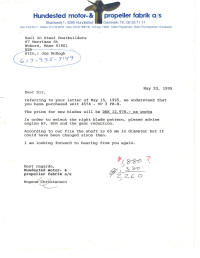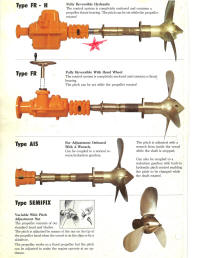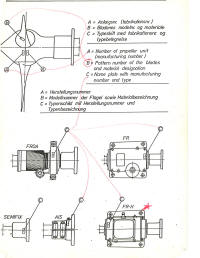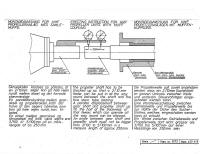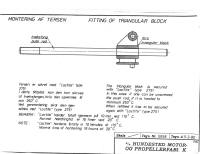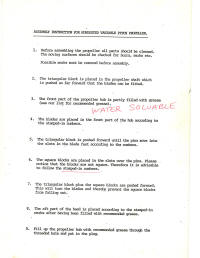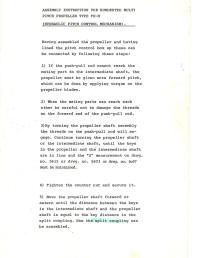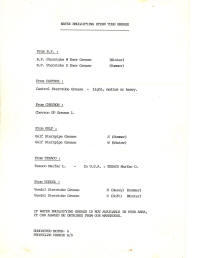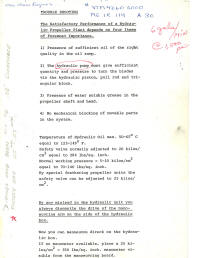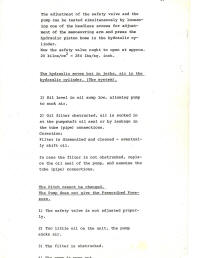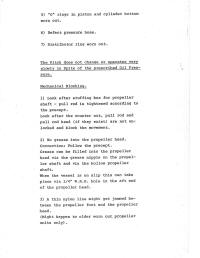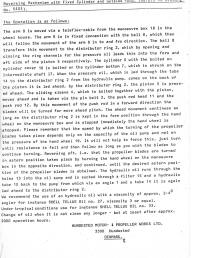Controllable Pitch Propeller
|
Why Controllable Pitch Propeller?
The benefits of controllable pitch propellers (CPP) specifically for a sailing/cursing/workboat are remarkable.
* The props speed vs. power can be adjusted according to varying
cargo loads.
* Drag can be reduced or increased to meet the sailing conditions.
* Prop walk can be reduced or made to push in either direction.
* Individual blades can be replaced.
* Save fuel motorsailing because you can pitch the blades to account
for the sails power.
Typically, the drop in propeller efficiency owing to the larger boss (prop hub) size of a controllable pitch propeller is about 2 percent. However, if a controllable-pitch propeller is well designed and correctly operated, it can result in fuel savings of up to 15 percent compared with a fixed-pitch propeller operating in a nozzle. --www.fao.org
But at What Cost?
The BIG down side to a controllable pitch prop is the cost. Hundested; www.hundestedpropeller.dk, is renown for some of the
best controllable pitch props so got a quote from McGowan Marine Inc. 1-508 990-1114
stevegow@aol.com, on a new system for a
74ft motor sailor is $66,913 plus shipping. Needless to say I
stopped thinking about a new Hundested CPP
system.
But Paul Liebenberg had two of the darn things, port and starboard,
sitting in Comox on Vancouver Island. The problems was that
Comox is 2300 miles from Tulsa Oklahoma, and the units had a vague
history and no blades. So we started by pricing replacement
blades from Hundested, which by the way is on a much smaller island
off the coast of Denmark. A set of blades was close to
$10,000. So we started looking into casting our own blades and once
we figured that was doable we set off for Comox for the starboard
side shaft and controller that was priced appropriate for the risk.
|
Our unit is a VP-3 FR-H and it must be 15 years old, but it turns
out Hundersted still has parts sitting on the self. And that
is a good thing because it turns out that we are missing the
distributor ring that cost a tidy $2,200 dollars. Ouch!
...and no, they will not give us the plans. Then after
we provided measurements for the muff on which the distributor ring
rides we were told it was too warn and a new one would coast another
$1,200. And no, they would not provide the tolerances.
Hundested Paten on a very similar design:
Hundested_VPP_Patent.pdf
Used Hundested VP-3 FR-H Teardown
|
|
The weather is getting colder so we moved the Hundested inside and starting taking it apart and cleaning it up.
Unfortunately we discovered that their is a collar for the hydraulic system missing from the controller. The real name from this is the distributor ring.
For support for Hundested you can actually call Mogens Christensen in Denmark who now owns the Hundested company. Or you can call Joel with Pacific Marine Equipment Sales in Seattle at 1-206 281 9841 . I've spoken to both, and both are very helpful, but Joel understands my Oki accent better. :)
Hundested VP-3 FR-H Rebuild
|
The first obvious problem is the missing distributor ring, which provides hydraulic oil pressure to the rotating muff. The ring connects with the actuator control arm that shifts the ring forward or backwards so that it provides oil to either one side or the other of the piston which in turn moves the center control rod that rotates the blades.
So just buy one right? Take a deep breath - $2,200 And the folks at Pacific Marine Equipment Sales and Hundested were smart enough to ask that the muff which the ring mounts over be measured. Guess what? Yup, it must have already been machined down, because while it's fairly uniform from 4.0111 to 4.0124", it's too small. A new one is $1,161.
So, we must buy a new distributor ring and muff for $3.5 grand, or buy a distributor ring and flame spray some metal back onto the muff and machine it to the proper size $2.5 grand, or we build a new distributor ring and put the money into a good lathe, $3 grand and I end up with a free lathe. Hmmmm.... Guess what Hundested? We got a lath that will pay for itself with he first part.
DIY Propeller Blades
|
Our used Hundested VP3 came without any blades. A new set cost about $8,000 and we wanted a spare set too. $16,000 is a huge pile of motivation for me and with some successful aluminum casting under my belt I decided to try it myself. This part of the project is all about pattern making, furnaces and casting and if that stokes your fire, you can read all about it here: Casting Boat Propellers
|
Once the blades are cast they still need to be machined to fit the hub. Hundested of course has a big lathe that can swing these parts. We would need a lathe with a 16 inch swing over the deck so our 12 x 36" Grizzly lathe is too small. But there is always more than one way to skin a cat.
|
So with a lot of assistance from Super Dave, doing what Super Dave does best we rigged a rotary table onto our CNC router table. The base of the blade is held in a 4 jaw chuck that is mounted onto the rotary table with an adapter plate. The rotary table is powered by a a windshield wiper motor connected to a 12 volt battery on a charger. There wiper motor can be turned on by a toggle switch but it is also connected to a 120 volt relay switch that is powered off the same circuit that powers the router. So when the CNC turns the router on and off, it also turns the wiper motor on and off. A double pole, double through rocker switch controls the direction of rotation of the wiper motor because rough cuts are best made against the direction of rotation, or "standard milling" and finish cuts are best with the direction of rotation or "climb milling".
It was slow going; taking about 15 hours to cut the groove and face the bottom of each blade. Writing simple g-code programs that slowly moved the bit was helpful but in the end moving the bit manually for all the rough cuts was faster as I could focus on the high spots and make sure the bit stayed loaded.
|
Cutting the notches was only 3 hours by comparison but much easier as the blades were each locked in place and g-code ran the CNC. We only had to check on it from time to time. The best tool bit by far was a 3/8" solid cabide with 6 flutes. Hogging bits over heated, and 2 or 3 flute bits would not take the pressure and snap off.
|
|
With the notches done we could finally fit three blades into the hub, and we could even actuate them without any grease. The next step is balancing them, and the range in weight between 31 and 33.7 pounds. Fortunately most are 32.2 pounds, because it takes a lot of grinding to remove 2.7 pounds of material. That heavy blade is actually beautifully shaped, it's just too thick.
So after a couple of nights and a day of grinding and shaving we have two beautiful looking sets of blades ready to decorate our patio until we can install them into the boat.
They still need to loaded with grease and for that job we have found two waterproof greases make for submersion in sea water. AquaShield Marine Grease Type 2, and LPS Thermaplex Aqua Bearing Grease Grade 2. The LPS product is more widely available and cost less too.
Hundested V-3 FR-H Documentation
Manufacture Number: 4574
Hydraulic pump maximum 19 inches above shaft.
Return line: 1.5" Pressure Line: .5"
Flow rate: 4 to 6.5 gallons / minute
Normal pressure: 70 to 140 psi
Relief pressure: 20 bar, 290 psi
Use 350 psi hydraulic pressure gauge on console.
Maximum hydraulic oil temperature 122 to 149 F.
Replace after 2000 hours or 2 years.
Hub material is magnesium bronze.
Hub and internal shaft uses water soluble.
Fill bolt holes with hard tallow, or machinable wax.
Use long cutlass bearing.
Shaft diameter: 65 mm
Propeller shaft to controller shaft alignment: .03 to .05 over 9.75"
Hydraulic oil degrees englar (E): 2 - 4
Mobil DTE light or DTE 24
Shell Turbo T32 or Tellus Plus 32
Texaco Regal R&O 32 or Rando HD 32
Conoco Hydroclear R&O 32 or Hydroclear AW 32
Hydraulic Supply
Cummins Power Steering Pump: Zahnradfabrik Friedrichshafen Type
76749?4150
Parker Cartridge Valves and Bodies from Aberdine Dynamics, Tulsa
OK. 918 437 8000, Johnny Tyler
Parker Cartridge
Specifications
Parker: Pilot Operated Pressure Reducing Valve
Primary Bypass - Adjust to open at 290 psi and supply other
equipment or dump back to Hundersted controller.
This simulates an autotive steering system that dumps excess when
the wheels are not being turned.
PRH082S10 $52.00 Pilot Operated Pressure Reducing Valve: 100 - 1000 psi, 8 gpm, 80 psi drop. Max 200F, Cartridge 3-port B08-3-A6T $27.50
3 port aluminum body for cartridge B08-3-A6T 3/8"
Parker: Pilot Operated Relief Valve
Regulates pressure suppled to controller to 290 psi, when the
controller is not using the supply the primary bypass will open
dump the excess pressure and flow.
RAH081S20 $48.50 Pilot Operated Relief Valve, 100 - 2000 psi
B08-2-A6T $19 Body 2-ports, 3/8" O-ring Port
Parts
Buna-N O-Rings Dash No: -233, -345, -435 and something about 1.5" OD out of the o-ring
kit for the push rod.
Seals:
CRI 60x85x10, HMS5 RG Seal
NAT 62x85x8, 41/S
Bearings:
Aft thrust bearing: Koyo 6413 Radial
Forward thrust bearing: Koyo 6315 Radial
|
